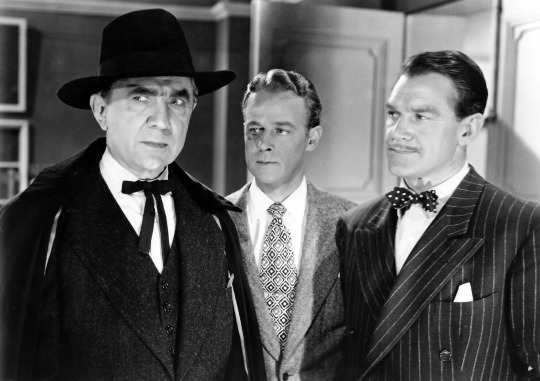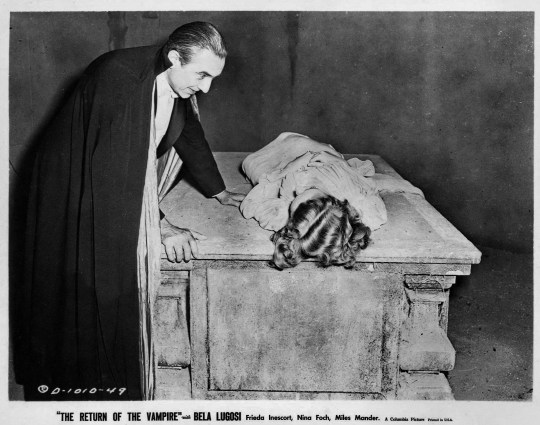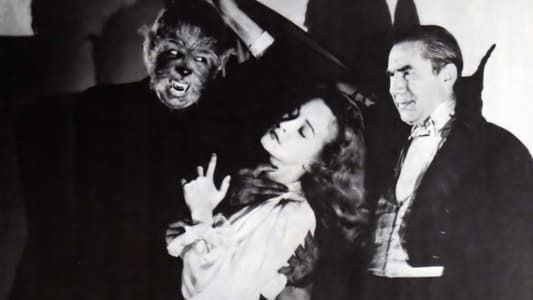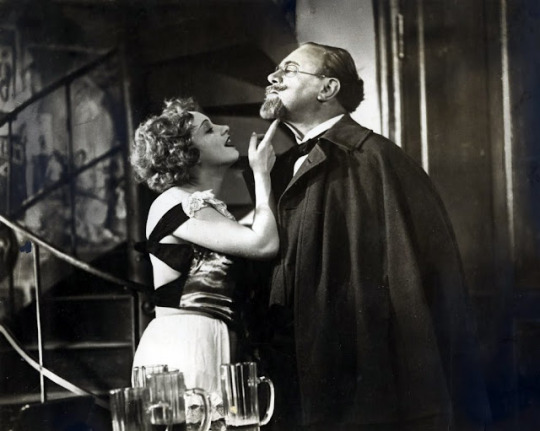#Roland Varno
Explore tagged Tumblr posts
Text

Roland Varno-Evelyn Ankers-John Craven "Vuelo sin rumbo" (Flight to nowhere) 1946, de William Rowland.
3 notes
·
View notes
Text

Bela Lugosi, Douglas Fowley, and Roland Varno in Scared to Death (1946)
#scared to death#bela lugosi#douglas fowley#roland varno#1946#1940s movies#christy cabbane#crime#mystery
25 notes
·
View notes
Text
Return of the Vampire 1943
Bela Lugosi










Unofficial follow-up to the 1931 Dracula movie. The movie was produced by Columbia Pictures and not Universal. This is the last time Lugosi was to receive top billing by any major Hollywood Studio.
2 notes
·
View notes
Text
Dread by the Decade: The Return of the Vampire
👻 You can support me on Ko-Fi! ❤️

★★½
Plot: During WWII, a vampire believed to have been defeated returns to terrorize a doctor and her family.
Review: Unique ideas are left by the wayside in favor of familiar cliches, with any potential mystery being given little time to breathe.

Year: 1943 Genre: Vampires, Werewolves Country: United States Language: English Runtime: 1 hour 9 minutes

Director: Lew Landers Writers: Randall Faye, Griffin Jay Cinematographer: L. William O'Connell Editor: Paul Borofsky Composer: Mario Castelnuovo-Tedesco Cast: Frieda Inescort, Nina Foch, Miles Mander, Roland Varno, Bela Lugosi, Matt Willis, Gilbert Emery

-----
Story: 2/5 - There are fun concepts—such as German blitzkriegs disturbing interred monsters—but everything is comically rushed, with characters reaching ridiculous conclusions in mere seconds just to forward the plot.
Performances: 2/5 - Lugosi seems to be phoning it in and Willis is outright rough to watch at points.
Cinematography: 4/5 - The film's most memorable feature. Very striking use of shadow.

Editing: 3/5
Music: 3/5 - Sometimes overbearing.
Choreography & Stunts 2/5 - Very stage-esque.
Effects & Props: 3.5/5 - Heavy fog lends a great deal to the atmosphere.
Sets: 3.5/5 - The cemetery sets are standouts.
Costumes, Hair, & Make-Up: 3/5 - Willis' werewolf make-up is quite decent.
youtube
Trigger Warnings:
Mild violence
Classist portrayal of working class British people
Child harm (off-screen)
#The Return of the Vampire (1943)#The Return of the Vampire#Lew Landers#vampires#Dread by the Decade#review#1940s#★★½
6 notes
·
View notes
Photo










Films watched in 2021.
311: My name is Julia Ross (Joseph H. Lewis, 1945)
★★★★★★★☆☆☆
“People can think themselves into anything.”
#Films watched in 2021#My name is Julia Ross#Joseph H. Lewis#1945#siete#film noir#noirvember#quote#joseph h lewis#Nina Foch#Dame May Whitty#George Macready#Anita Bolster#Roland Varno#intrigue#b series#poison#windows#bed#fire#black and white#Julia Ross#animals#cats#sea#hands#back#sleep
273 notes
·
View notes
Photo



12 notes
·
View notes
Audio
It's Bela Lugosi in colour in SCARED TO DEATH (1947) from director Christy Cabanne! This bonkers movie also stars George Zucco, Molly Lamont, Douglas Fowley and many others. It can only be experienced for yourself, so sit back and enjoy the ride!
Context setting 00:00; Synopsis 13:28; Discussion 27:53; Ranking 48:41
#podcast#bela lugosi#george zucco#nat pendleton#molly lamont#joyce compton#gladys blake#roland varno#douglas fowley#stanley andrews#angelo rossitto#lee bennett#stanley price#screen guild productions#golden gate pictures#independent horror#horror film#classic horror#classic film#marcel lepicard#carl hoefle#george mcguire#christy cabanne#wj abbott#scared to death#cinecolor#poverty row
9 notes
·
View notes
Photo



Greta Garbo with Owen Moore, Albert Conti and Roland Varno in As You Desire Me (1932)
15 notes
·
View notes
Photo

My Name Is Julia Ross (1945) Joseph H. Lewis
December 3rd 2019
#my name is julia ross#1945#joseph h. lewis#nina foch#dame may whitty#george macready#roland varno#anita sharp-bolster#doris lloyd#queenie leonard#joy harington
3 notes
·
View notes
Photo



Der blaue Engel (1930) · Josef von Sternberg
#the blue angel#josef von sternberg#marlene dietrich#roland varno#emil jannings#der blaue engel#heinrich mann
34 notes
·
View notes
Video
Eva Speyer da Truus, Bob & Jan too! Tramite Flickr: German postcard. Photo: Alex Binder. Eva Speyer (1883-1932 (?)), also known as Eva Stöckl Speyer, was a German actress, who appeared in more than seventy films from 1911 to 1932. Eva Speyer was born Eva Esther Speier in 1883 in Berlin, Germany. She was the daughter of the stockbroker Fedor Speier and his wife, the milliner Wilhelmine, née Mahn. Eva received her training as an actress at the Marie Seebach School and made her debut in Hirschberg in 1904. In 1905 she appeared in Posen and from 1906 to 1908 at the Schauspielhaus Düsseldorf. In 1908 she embarked for America and appeared on stage in Milwaukee and in 1909 in New York. In November 1910 she returned to Germany and played at Berlin stages such as the Lessingtheater, Trianon-Theater, and the Kleines Theater. She got in touch with the film business by chance. During an engagement at the Lessingtheater, she was asked by Paul Otto to play in the silent film Nora (1911). The new medium film was becoming commercially successful in Germany. Thomas Staedeli at Cyranos: "She viewed the new medium as a welcome extra income without artistic challenge. When the technological basis improved considerably she changed her attitude to the film and saw the possibility to make the art accessible to the audience in an easy way." In the next years, Speyer developed into one of the first stars of the German silent cinema. She played suffering women in such short melodramas as Die gelbe Rasse/The yellow breed (Max Mack, 1912), Dämonen der Tiefe/Demons of the Deep (Harry Piel, 1912), and Zwischen Himmel und Erde/'Tween Heaven and Earth (Otto Rippert, 1913) with Ernst Rückert. During World War I, Eva starred in films like Der Geisterseher/The Ghost Seer (Waldemar Hecker, 1915), Der Talismann/The Talisman (Eddie Seefeld, 1915), Die Flucht des Arno Jessen/The Flight of Arno Jessen (Richard Eichberg, 1917) starring Ernst Rückert, and Es werde Licht! 2. Teil/Let there be light. Part 2 (Richard Oswald, 1918). She played the female lead in the silent Science-Fiction film Die Arche/The Ark (Richard Oswald, 1919) starring Leo Connard. It is a two-part German epic about a near future in which civilisation has been destroyed. From the 1920s onwards, Eva Speyer's days as a star were over but she proved her talent as a character actress in many well-known films. These included § 182 minderjährig/Paragraph 182 (Ernst Winar, 1927) starring Colette Brettel, Dirnentragödie/Tragedy of the Street (Bruno Rahn, 1927) starring Asta Nielsen, and Unter der Laterne/Under the Lantern (Gerhard Lamprecht, 1928) starring Lissy Arna. In the drama Jugendtragödie/Tragedy of Youth (Adolf Trotz, 1929), she played a washerwoman, whose son (Roland Varno) is sent to a reform school for a minor crime. He breaks out and commits a murder. During the sound era, Speyer appeared in three more films, Namensheirat/Marriage in Name Only (Heinz Paul, 1930) with Evelyn Holt, the comedy Ich bleib bei Dir/I stay with you (Johannes Meyer, 1932), and the drugs drama Der weisse Dämon/The White Demon (Kurt Gerron, 1932) starring Hans Albers. Speyer was initially married to the actor Otto Stöckl and was therefore also known as Eva Speyer-Stöckl. In 1918, she was married to merchant Robert Ebert in her second marriage. About what happened to her after 1932, the sources differ. According to German Wikipedia, she was completely excluded from public culture because of her Jewish descent after the National Socialists came to power in 1933. and probably emigrated a short time later. However, Italian Wikipedia quotes IMDb that indicates that the actress died in 1932 at the age of 50. Where is unknown. Filmportal.de confirms this date. Sources: Thomas Staedeli (Cyranos), Filmporttal.de, Wikipedia (English, German and Italian), and IMDb. And, please check out our blog European Film Star Postcards.
#Eva Speyer#Eva#Speyer#German#Actress#Actrice#European#Film Star#Film#Cinema#Kino#Picture#Screen#Movie#Movies#Filmster#Star#Vintage#Postcard#Carte#Postale#Cartolina#Tarjet#Postal#Postkarte#Postkaart#Briefkarte#Briefkaart#Ansichtskarte#Ansichtkaart
4 notes
·
View notes
Photo

02-28-2017 Letter From An Unknown Woman (1948) http://www.imdb.com/title/tt0040536/
Letter From An Unknown Woman is the second of four American feature films directed by the German born Jewish filmmaker Max Ophüls. It is the most highly regarded of his American films, and by far my personal favorite. Rarely have I been so moved by a romantic movie, but I could identify with both characters. Perhaps it is because I am in love myself, but I found this movie beautiful.
Based on the 1922 novella of the same name by Stefan Zweig does it tell the story of young Lisa Berndle (Joan Fontaine), who falls in love with the pianist Stefan Brand (Louis Jourdan), the new tenant in the building she lives in. It takes some time for the coy Lisa to come to the attention of Stefan, a wealthy bachelor, but he falls for her just as hard as she falls for him when they finally make eye contact. They spend a romantic time together, but Stefan disappears from her life as sudden as he entered it. Years later does Stefan receive a letter, starting ‘’by the time you read this letter, I may be dead.’’
It is a tragic start of a film, raising a question that I was afraid to have answered. Will Lisa commit suicide? The drama is only raised when we realize Stefan is about to enter a duel he is sure to lose, why can’t these two be together?
I was enchanted from the very start. The snowy setting in romantic Vienna, the beautiful music (by the well-respected composer Daniele Amfitheatrof), the marvelous acting (Fontaine is perfect, she goes from innocent little girl to a married woman and a mother, back to innocent girl she was in just a second by just a glimpse); it embraced me, the warm and elegant directing by Ophüls being the cherry on the cake. I have never had so much hope that two fictional characters would share a final act together.
10
#letter from an unknown woman#max ophüls#max ophuls#max opuls#stefan zweig#joan fontaine#louis jourdan#daniele amfitheatrof#mady christians#marcel journet#howard freeman#erskine sanford#otto waldis#william gould#edna holland#mauritz hugo#roland varno#cy stevens
1 note
·
View note
Text
[Last Film I Watched] The Blue Angel (1930)
[Last Film I Watched] The Blue Angel (1930)
English Title: The Blue Angel Original Title: Der blaue Engel Year: 1930 Country: Germany Language: German, English, French Genre: Drama, Music Director: Josef von Sternberg Writers: Carl Zuckmayer Karl Vollmöller Robert Liebmann based on the novel of Heinrich Mann PROFESSOR UNRAT Cinematography: Günther Rittau Cast: Emil Jannings Marlene Dietrich Kurt Gerron Rosa Valetti Hans Albers Rolf Müller
View On WordPress
#1930#7.4/10#Black & White#Carl Balhaus#Edward von Winterstein#Emil Jannings#German Film#Hans Albers#Ilse Fürstenberg#Josef von Sternberg#Kurt Gerron#Marlene Dietrich#Roland Varno#Rolf Müller#Rosa Valetti#Wilhelm Diegelmann
0 notes
Photo

Marlene Dietrich and Emil Jannings in The Blue Angel (Josef von Sternberg, 1930) Cast: Emil Jannings, Marlene Dietrich, Kurt Gerron, Rosa Valetti, Hans Albers, Reinhold Bernt, Eduard von Winterstein, Hans Roth, Rolf Müller, Roland Varno, Carl Balhaus, Robert Klein-Lörk, Károly Huszár, Ilse Fürstenberg. Screenplay: Carl Zuckmayer, Karl Vollmöller, Robert Liebmann, based on a novel by Heinrich Mann. Cinematography: Günther Rittau. Art direction: Otto Hunte. Film editing: Sam Winston. Music: Friedrich Hollaender Josef von Sternberg's The Blue Angel still has some of the earmarks of a film made during the transition from silence to synchronized sound, namely the tendency to hold a shot a beat or two longer than is actually necessary, so the narrative doesn't always move along at the speed we anticipate. But Sternberg is clearly ready for sound, as the final scene shows. The camera tracks back from the dead professor, clutching his old desk so tightly that the caretaker who found his body has been unable to loosen his grip. Meanwhile, we hear the clock striking midnight, with the twelfth stroke barely audible as the screen fades to black. It's a touching moment, made possible by the several shots and sounds of the clock that occur through the film as a kind of indicator of Rath's decline from precise and punctual to dissipated and tardy. Otherwise the sound on the film is sometimes a little harsh to the ear, which makes Sternberg's relatively sparing use of it welcome. Many scenes are staged in near-silence, letting the action rather than the dialogue carry the story. Marlene Dietrich's baritone recorded well, which is one reason her career took off when sound was introduced, but early in the film she's allowed to sing in an upper key which is more than a little off-putting. Fortunately, by the time we get to Lola Lola's big number, Friedrich Hollaender's "Ich bin von Kopf zu Fuß auf Liebe eingestellt" (the subtitles use the English language version, "Falling in Love Again" instead of a literal translation), Dietrich is back in the correct register. The Blue Angel thrives on Dietrich's performance, which eclipses Emil Jannings's overacting, though he does provide some genuine pathos toward the end of the film. I don't quite believe the ease with which the professor falls from grace, but I'm not sure whether the fault lies entirely with Jannings or with the screenplay.
0 notes
Photo

The Return Of The Vampire (1943)
The Return of the Vampire is a 1943 American horror film directed by Lew Landers and starring Bela Lugosi, Frieda Inescort, Nina Foch, Miles Mander, Roland Varno, and Matt Willis. Its plot follows a vampire named Armand Tesla, who has two encounters with Englishwoman Lady Jane Ainsley, the first taking place during World War I, and the second during World War II.
The Return of the Vampire is not an official sequel to the 1931 Universal Studios film Dracula (which starred Lugosi as the eponymous vampire), but the film has been interpreted by cultural historian David J. Skal as an unofficial follow-up, with Lugosi's character renamed only because the film was not produced by Universal.
0 notes
Photo






My name is Julia Ross (Joseph H. Lewis, 1945)
#My name is Julia Ross#Joseph H. Lewis#joseph h lewis#Nina Foch#Roland Varno#film noir#noirvember#marriage#kiss#final scene#1945#black and white#time
196 notes
·
View notes